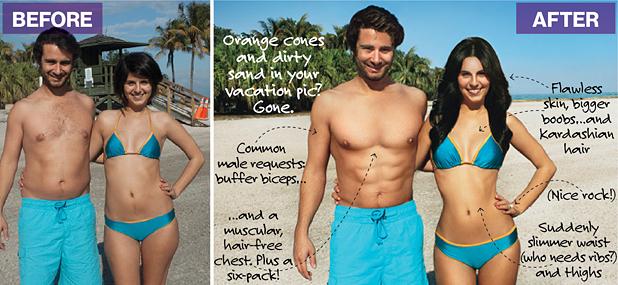Warning: This Image is Not as Real as it May Appear
Photo by Photo from MCT Campus
This photo exhibits the effects of photoshop and how what we see isn’t always reality.
February 26, 2014
Wouldn’t it be great if we could all look like the celebrity icons on magazines? Ladies, how awesome would it be if we had perfect facial features and skinny, toned bodies? And guys, wouldn’t you love to have a six pack and ripped arm muscles?
It’s reassuring, however, to know that these icons we see plastered on billboards and advertisements are at least (in part) fake. We strive to be “perfect,” when our perception of what is truly perfect is distorted through advanced technology use in programs like Photoshop.
Unfortunately for many, the false advertising can trigger serious problems for those who strive a little too much to be what society tells us is beautiful. We are constantly bombarded with pictures of photo shopped bodies that are not only unrealistic, but entirely unattainable. The Center for Eating Disorders in Baltimore said how our media’s growing obsession with being thin can contribute to people with and without eating disorders by promoting unrealistic body images.
Anorexia is a serious eating disorder that is nearly impossible to cure 100 percent of the way. The potentially life-threatening disease is characterized by excessive weight loss, negative body image, and self-starvation. Although most common for females, about 15 percent of people with anorexia are males. It is the third most common illness among adolescents in the United States, according to Harry Brandt, the director of the Center for Eating Disorders.
The National Eating Disorders Association claims there has been a rise in cases of anorexia in young women ages 15-19 each decade since 1930. Besides sometimes drastic changes in personality, people who suffer from anorexia face a major list of long term medical complications, including a drop in internal body temperature, infertility, reduction of bone density.
If we could all help just a little bit to prevent this disease, shouldn’t we?
Dove produced a viral video that they released to YouTube in 2010. Titled Dove ad: The Evolution of Beauty, it shows a time lapse of a model gone from her natural beauty to an altered billboard image of her. Safe to say the women in the video looks like two different people from beginning and end.
Glamour magazine has also released an article on retouching with an accompanied photograph to show exactly what Photoshop is capable of. The magazine has decided to take a stand against this horrible trend of retouching. The editor in chief, Cindi Leive has promised to limit the magazines use of retouching, and won’t slim down a cover girl even if she wants to be thinned.
In 2012, Glamour polled 1,000 of its readers, asking how much retouching is too much. Seventy-seven percent of readers were okay with removing blemishes and 75 percent were okay with removing wrinkles in clothing and stray hairs– the little things. But the more dramatic changes got much less approval. Sixty percent of readers said they do not want misleading ads, and only 22 percent agreed with slimming a body to look even five pounds lighter. The majority of women clearly do not like false advertising.
Susie Orbach, author of Bodies and Fat is a Feminist Issue said, “by creating an image of the person you would like to be but aren’t, you start to think, what I am is really rather awful, instead of saying, hey, I am who I am. Women are waking up and looking in the mirror and thinking, all these things are wrong!” Clearly, false advertising does nothing but make a person feel better about their fake selves, while tearing down the person they really are. Is that how we want society to be? Ashamed of who they are
However, there are other theories behind the causes of anorexia. Psychologist Dr. Ian Frampton of Exeter University believes that small problems in early brain development make patients susceptible to anorexia and other mental health problems. But only up to one-third of sufferers of serious mental health problems are affected by this specific brain abnormality.
What about the majority– the other two-thirds? Scientific studies don’t need to be conducted to prove that false advertising and sliming of both male and female bodies is not beneficial towards anyone’s self esteem. It may not be the sole cause of anorexia, but it doesn’t help either.
Of course anorexia can not be cured overnight, but we can help by being aware of the dangers today. Let’s stop companies from being allowed to Photoshop bodies completely. Let’s get the countless amount of published magazines to join Glamour in the stop to Photoshop. Sign an online petition by Carina Cruz and Emma Stydahar to ban the use of Photoshop in Teen Vogue magazine at www.change.org. We can capture one magazine at a time. Spread the word, and know that we can make a change. Don’t let false advertising contribute to the growth rates of anorexia.


